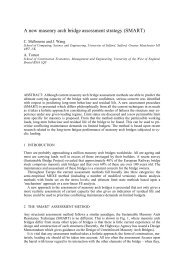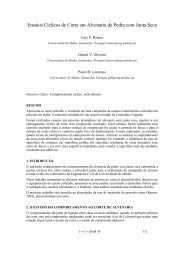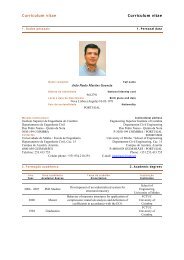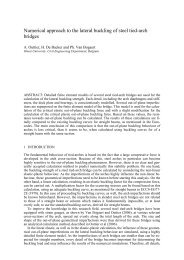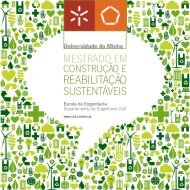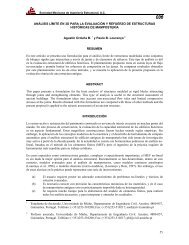Sustainable Construction A Life Cycle Approach in Engineering
Sustainable Construction A Life Cycle Approach in Engineering
Sustainable Construction A Life Cycle Approach in Engineering
Create successful ePaper yourself
Turn your PDF publications into a flip-book with our unique Google optimized e-Paper software.
Environmental assessment should be <strong>in</strong>cluded <strong>in</strong> the simulation of the build<strong>in</strong>g performance.<br />
Even though the simulation is often part of the architectural process, it is after resolv<strong>in</strong>g several<br />
design and plann<strong>in</strong>g decisions, or even later (Thoo, 2008). Aga<strong>in</strong>, the later the simulation is<br />
done, the fewer possibilities it has to <strong>in</strong>fluence the design itself. The later the changes are done,<br />
the higher the costs are (Figure 1). If major flaws exist <strong>in</strong> the design, it is difficult, if not impossible,<br />
to significantly improve the build<strong>in</strong>g performance later.<br />
Figure 1 The cost of implement<strong>in</strong>g performance improvements contrasted with the effect on build<strong>in</strong>g performance<br />
(based on Thoo, 2008).<br />
The build<strong>in</strong>g’s design is largely specified by different regulations and build<strong>in</strong>g codes. Moreover,<br />
different actors <strong>in</strong> the build<strong>in</strong>g sector have different requirements for the build<strong>in</strong>gs. Different<br />
build<strong>in</strong>g components and structural solutions can meet these regulations and requirements,<br />
but optimis<strong>in</strong>g and compar<strong>in</strong>g these different solutions is challeng<strong>in</strong>g. Optimis<strong>in</strong>g one<br />
solution may not be the ideal solution for the whole build<strong>in</strong>g; chang<strong>in</strong>g a build<strong>in</strong>g product <strong>in</strong><br />
one place may cause changes elsewhere. Thus, it is essential to <strong>in</strong>tegrate environmental assessment<br />
of build<strong>in</strong>gs <strong>in</strong> the simulation of the build<strong>in</strong>g performance right from the beg<strong>in</strong>n<strong>in</strong>g of the<br />
design process. Through simulations, the build<strong>in</strong>g performance could be cont<strong>in</strong>ually ref<strong>in</strong>ed<br />
and improved (Thoo, 2008). Includ<strong>in</strong>g the environmental aspect to the design process from the<br />
beg<strong>in</strong>n<strong>in</strong>g would be a competitive strength. Awareness of environmental and energy efficiency<br />
issues related to build<strong>in</strong>g design and construction is <strong>in</strong>creas<strong>in</strong>g.<br />
1.1 Aim of the study<br />
The exist<strong>in</strong>g build<strong>in</strong>g environmental assessment methods and tools should not be underestimated.<br />
However, they should not be considered the sole possibilities. All the important aspects<br />
may not be considered <strong>in</strong> the environmental assessment of build<strong>in</strong>gs. (Haapio, 2008) Therefore<br />
it is important to widen the viewpo<strong>in</strong>t. The aim of this study is to analyse the role of environmental<br />
assessment of build<strong>in</strong>gs. Moreover, the role of build<strong>in</strong>g environmental assessment tools<br />
<strong>in</strong> the <strong>in</strong>tegrated model is discussed. Could build<strong>in</strong>g <strong>in</strong>formation modell<strong>in</strong>g (BIM) be seen as an<br />
<strong>in</strong>tegrative element between susta<strong>in</strong>able build<strong>in</strong>g, and decision mak<strong>in</strong>g<br />
1.2 Content of the study<br />
In the first section, the research area is briefly <strong>in</strong>troduced, the aim of the study is stated, and the<br />
content of the study is listed. In the second section, the focus is on the role of the environmental<br />
assessment of build<strong>in</strong>gs. Build<strong>in</strong>g environmental assessment tools and build<strong>in</strong>g <strong>in</strong>formation<br />
modell<strong>in</strong>g (BIM) are <strong>in</strong>troduced, and the possibilities of the simulations are highlighted. In the<br />
third section, the service life plann<strong>in</strong>g, ma<strong>in</strong>tenance and obsolescence are discussed. In the<br />
forth section, the results of this study are highlighted.<br />
18


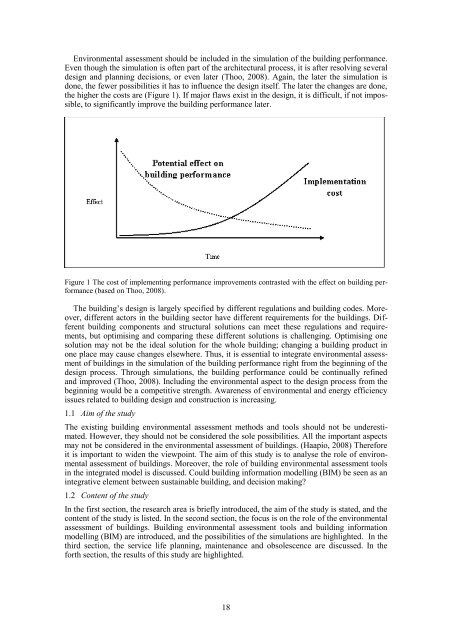
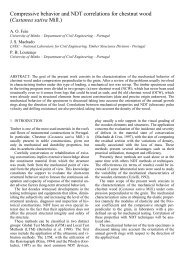
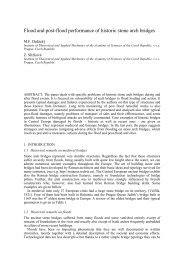
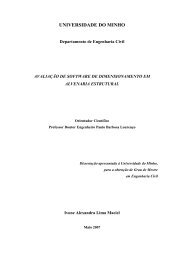
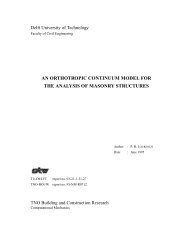

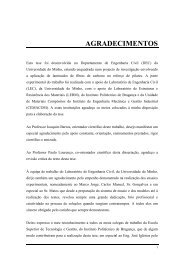

![Weibull [Compatibility Mode]](https://img.yumpu.com/48296360/1/190x134/weibull-compatibility-mode.jpg?quality=85)

